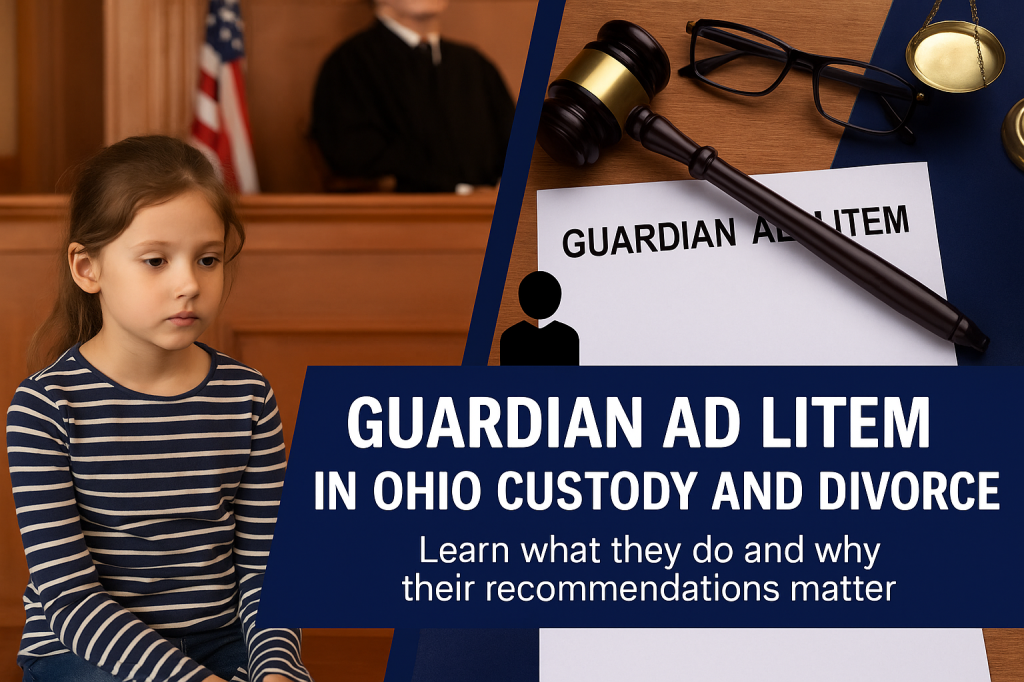Role of the Guardian Ad Litem in Ohio Custody and Divorce
- Jul 30
- 5 min read
By Andrew Russ, Ohio Family Law Attorney https://www.andrewrusslaw.com/

Table of Contents
Introduction
What Is a Guardian Ad Litem (GAL)?
Legal Authority and Ohio Rules Governing GALs
When Is a GAL Appointed in Ohio Custody Cases?
Duties and Responsibilities of a GAL
The GAL’s Investigation Process
The GAL’s Report and Recommendations
How Courts Use the GAL’s Input in Decision-Making
Costs and Who Pays for the GAL
Challenging or Replacing a GAL in Ohio
GALs in High-Conflict Custody or Divorce Cases
Benefits and Drawbacks of Having a GAL
How to Work Effectively With a GAL
Conclusion: Protecting the Child’s Best Interests
Related Blog Posts
1. Introduction
In Ohio family law proceedings, especially those involving contested custody or parenting time, the role of a Guardian Ad Litem (GAL) is pivotal. Whether you’re facing a complex divorce or a custody dispute, understanding how a GAL functions—and how their recommendations influence the court—can have a significant impact on the outcome of your case.
This article explores the role, appointment, powers, and practical influence of Guardians Ad Litem in Ohio divorce and custody proceedings, providing insight for parents navigating these sensitive legal matters.
2. What Is a Guardian Ad Litem (GAL)?
A Guardian Ad Litem is a court-appointed individual—usually an attorney or trained advocate—tasked with representing the best interests of the child in legal proceedings.
The GAL is not a parent’s attorney or the child’s direct representative. Instead, the GAL functions as an independent investigator and advisor to the court, focusing solely on the child’s welfare.
3. Legal Authority and Ohio Rules Governing GALs
GALs in Ohio are governed by:
Ohio Revised Code § 2151.281 (primarily for juvenile court matters)
Ohio Revised Code § 3109.04 (allocation of parental rights)
Supreme Court of Ohio Rules of Superintendence Rule 48
Local Rules of Domestic Relations and Juvenile Courts
These rules outline qualifications, appointment procedures, investigation standards, reporting requirements, and continuing education obligations. Attorneys serving as GALs must complete 12 hours of pre-service training and ongoing education.
Rule 48 was updated in 2021 to reinforce accountability and transparency in the GAL’s role.
4. When Is a GAL Appointed in Ohio Custody Cases?
In Ohio, a GAL is typically appointed in:
High-conflict custody disputes
Allegations of abuse or neglect
Relocation requests or parental alienation concerns
Cases involving unfit parenting, substance abuse, or mental health issues
Requests by either parent, their attorney, or by the court itself
Judges have discretion in appointing a GAL but will generally do so when the child’s interests need special attention distinct from the parents’ legal arguments.
5. Duties and Responsibilities of a GAL
Under Rule 48 and related court rules, a GAL in Ohio must:
Meet with the child and observe interactions
Interview parents, caregivers, teachers, doctors, and others
Review records (school, medical, criminal, etc.)
Attend court hearings and provide testimony if needed
File written reports and recommendations
A GAL does not make the final decision—that power rests with the judge or magistrate—but their findings carry weight in custody, parenting time, and decision-making authority.

6. The GAL’s Investigation Process
The GAL’s investigation may include:
Initial meetings with each parent separately
Home visits and child interviews (often both parents’ homes)
Review of school reports, grades, and behavioral notes
Medical, psychological, or substance abuse evaluations
Talking to other adults who influence the child’s life (e.g., coaches, therapists)
The GAL uses this comprehensive picture to form an opinion about the child’s best interests, including which living arrangement provides the most stable and nurturing environment.
7. The GAL’s Report and Recommendations
A key task for every GAL is submitting a written GAL Report. This document summarizes:
The investigation findings
Observations of the child and both parents
Risks and concerns (e.g., abuse, neglect, instability)
Concrete recommendations regarding:
Legal custody
Parenting schedules
Supervised visitation
Other special conditions
The GAL may testify at trial and be cross-examined. Judges often give significant deference to the GAL’s input, especially if supported by solid investigation and documentation.
8. How Courts Use the GAL’s Input in Decision-Making
In Ohio, the best interests of the child standard governs custody and visitation decisions. Courts consider multiple factors under R.C. § 3109.04(F)(1), and GAL recommendations provide vital input on:
Stability of each parent’s household
Emotional ties between parent and child
History of abuse or neglect
Parental cooperation and communication
The child’s wishes (if old/mature enough)
While not binding, the GAL’s opinion often heavily influences the court’s ruling, especially when other evidence is conflicting or inconclusive.
9. Costs and Who Pays for the GAL
GAL services are not free unless the family qualifies as indigent. The court may assign fees to:
One parent, often the one requesting the GAL
Both parents, split equally or proportionally
County funds, in some juvenile or dependency cases
GAL fees can range from $500 to several thousand dollars, depending on complexity, hours worked, and county practices. Parents may be required to deposit money with the court in advance.
10. Challenging or Replacing a GAL in Ohio
If a party believes the GAL is:
Biased or unprofessional
Failing to conduct a thorough investigation
Neglecting duties under Rule 48
…they can file a motion to remove or replace the GAL. However, courts typically require compelling evidence and do not take such requests lightly.
Complaints may also be directed to the local court administrator or state bar association if serious misconduct is suspected.
11. GALs in High-Conflict Custody or Divorce Cases
In contentious divorces or custody disputes involving accusations, GALs serve as neutral figures who:
De-escalate parent conflict
Ensure children are heard
Provide fact-based insight to the court
Reduce reliance on parent “he said/she said” arguments
GALs are particularly helpful when one parent accuses the other of parental alienation, mental health instability, or domestic violence, since they can investigate independently.
12. Benefits and Drawbacks of Having a GAL
Pros:
Brings child-focused analysis to court
Helps the judge make informed custody decisions
Gives children a voice, especially in younger years
Can uncover facts not accessible through standard legal filings
Cons:
Expensive for families already facing financial strain
Risk of bias or insufficient investigation
Parents feel “evaluated” and under scrutiny
Not always aligned with what the child wants
Working proactively with a GAL—by cooperating, providing documentation, and acting in good faith—can help mitigate potential drawbacks.
13. How to Work Effectively With a GAL
Parents can help their case by:
Being honest and cooperative
Providing requested documents and contacts promptly
Avoiding disparaging the other parent
Focusing on the child’s needs, not grievances
Respecting the GAL’s time and role
Treat the GAL as a neutral professional, not an adversary. The more transparent and child-centered you are, the more likely the GAL’s report will reflect that favorably.

14. Conclusion: Protecting the Child’s Best Interests
In Ohio divorce and custody proceedings, the Guardian Ad Litem plays a critical role in ensuring that the child’s best interests are front and center. Whether navigating shared parenting, sole custody, or visitation schedules, the GAL’s recommendations can strongly shape the final outcome.
If you’re involved in a custody case and a GAL has been—or may be—appointed, having knowledgeable legal guidance is essential. At Andrew Russ Law, we’ve helped hundreds of Ohio families navigate GAL involvement with clarity and confidence.
15. Related Blog Posts
LINKS:




